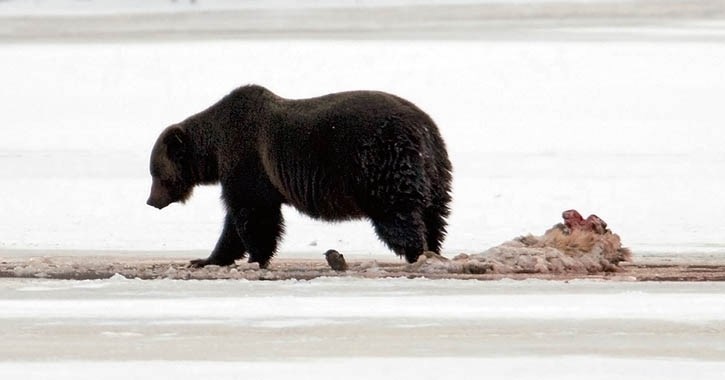Parks Canada wildlife experts decided to let nature take its course when a cow elk fell through thin ice on the Bow River in the Banff townsite on the weekend.
Resource conservation officers responded to a report at 4 p.m. on Saturday (March 12) of an elk falling through melting ice just upstream of the canoe docks, in about the same location where dominant male grizzly bear 122 in 2013 feasted on an elk that fell through the ice and drowned.
“We got a report that an elk was floundering in the water there on Saturday afternoon,” said Steve Michel, human-wildlife conflict specialist with Banff National Park. “We made a decision not to intervene in this case and just let nature take its course.”
In making the decision, Parks Canada considered staff safety as well as public safety.
They deemed it would have been unsafe to send staff out onto the melting ice at the time, but decided to remove the carcass the following morning, with the expert help of the visitor safety team, amid fears the carcass could attract carnivores such as bears, wolves or coyotes.
“Unfortunately, the carcass had slipped under the ice overnight and was not visible to us,” said Michel.
“It washed downstream some distance, we’re not sure how far, and we’re not able to locate the carcass at this time.”
Resource conservation officers will monitor the area to see if the carcass appears somewhere else.
Michel said they would review options, depending on where the carcass turns up.
“If it turns up anywhere where people frequent, that’s a concern to us, and we’d remove it. But if it’s in a more remote area, where the odds of someone coming across it are low, we might be able to put an area closure into effect,” he said.
“We know with a large carcass like an elk that it’s going to be very attractive to carnivore species like grizzly bears, black bears, wolves and coyotes, as well as to scavengers.”
In November 2013 in the lead up to hibernation, bear 122 enjoyed a high-calorie feast from Nov. 13-20 on an elk that had fallen through thin ice, prompting wildlife officials to close the area to prevent people from stumbling across the scene, as well as to give the grizzly bear space and security to feed.
Michel said the location is a common travel path for elk to get across the river to marshy habitat near the stables in Banff.
“In terms of falling though the ice, we see this on an occasional basis in spring because the ice is melting, and we also see it at the other end of the season in November when the ice is still thin,” said Michel.
The cow elk that died on the weekend was a collared animal.
Parks Canada keeps a sample size of marked animals around town as part of the overall elk management strategy to try to determine how many elk migrate and how many stay close to town.
A small number of elk are culled every year as part of that strategy.
“This was not a problem animal and not one that was slated for removal,” said Michel. “This was an adult cow not causing us any real behavioural concerns.”




